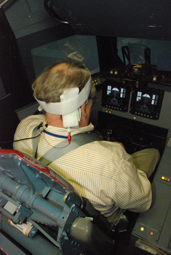Spending significant time in reduced gravity can cause sensorimotor problems for astronauts. These problems can have an effect on docking and landing operations and post-landing activities.
Dr. Steven Moore has developed a prototype system that simulates post-flight sensorimotor effects. The system uses Galvanic vestibular stimulation (GVS), which uses electrodes behind the ear to safely induce the symptoms of post-flight sensorimotor disruption. The system accurately reproduces postural, locomotor, gaze and perceptual deficits observed in astronauts following short- and long-duration missions, without inducing significant motion sickness symptoms. Moore and colleagues seek to bring the system to operational readiness by answering three questions: What are the best operational parameters for using GVS; what is the long-term response to GVS; and how well does GVS reproduce post-flight deficits in shuttle landing performance.







